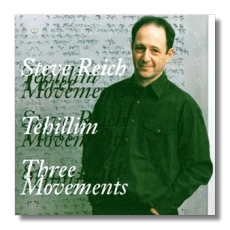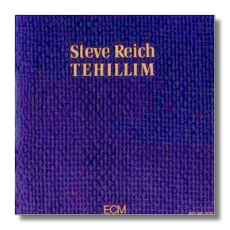
The Internet's Premier Classical Music Source
Related Links
- Reich Reviews
- Latest Reviews
- More Reviews
-
By Composer
-
Collections
DVD & Blu-ray
Books
Concert Reviews
Articles/Interviews
Software
Audio
Search Amazon
Recommended Links
Site News
 CD Review
CD Review


- Tehillim
- Three Movements for Orchestra
Schoenberg Ensemble
Percussion Group The Hague/Reinbert de Leeuw;
London Symphony Orchestra/Michael Tilson Thomas
Elekta/Nonesuch 9-79295-2
I first encountered the music of Steve Reich in, of all places, a graduate seminar on modern English grammars: the two tape pieces, Come Out and It's Gonna Rain. I had no idea who Steve Reich was or had even heard the name before, and I was interested in new music. How the professor had gotten hold of these things I can't tell you, but Reich for me became a name to look for. In the late 1970s, I began to run across his music at specialists' concerts: Music for Large Ensemble, Music for 18 Musicians (a revelatory live experience, by the way), and Music for Mallet Instruments. Reich seemed to me a mind both incredibly methodical as well as exploratory. Each piece seemed to show a logical progression from what he had produced before. The two tape pieces experimented with two tape machines playing and recording the same phrase over and over. Because two machines seldom run at precisely the same speed, the material moved in and out of "phase." Through overdubbing, Reich generated an elaborate rhythmic counterpoint. Piano Phase took this idea further, but this time a human being generated the music. Reich then applied the idea to ensemble. I would love to hear all of Reich's work in order of composition, so I can journey with him. Reich somehow got stuck with the minimalist label, which I never understood. To me, a minimalist is someone like Glass, who runs a tonality into the ground, or Górecki, who plays two notes to the minute. Although Reich shares the expanded time sense of many minimalists (changes happen over the long haul), his surfaces scintillate like a hive of bees. The most obvious comparison is to Balinese gamelan music, although I'm not sure whether Reich (even though a percussionist) had heard actual examples at the time he began to create his own music.
Against the odds, Reich actually makes a nice living from music. He tours like a rock demi-star, with his own group, to a large extent independent of academia and the commercial classical music world of impresarios and publishers. As far as I know, he's never taught. Furthermore, Reich has in fact avoided publishing and recording some of his most effective work, since he feels that the resultant competition may detract from the box-office gate of his tours. If you want to hear this music, you've got to buy a ticket.
Many long-time watchers along the Reich were somewhat nonplussed by Tehillim (Hebrew for "psalms"). Instead of regular rhythmic patterns slowly varied over a stretch of time, the patterns themselves were complexly asymmetrical. Reich, of course, had seldom repeated himself from piece to piece, so they should have expected this. Reich himself explains the change as a matter of dealing with the rhythms of text for the first time. Almost every composer who has set words finds himself coming up with phrasing and declamation different than for purely instrumental music. For example, when Holst writes "advanced rhythms" for orchestra, they are generally odd meters but arranged in a regular pattern ("Mars" from The Planets, for instance). On the other hand, I know of no Holst instrumental work with the rhythmic oddities of his song "Persephone" (from Twelve Humbert Wolfe Songs). These tics in the line come about solely from the rhythms of the poem. Again, Reich works with the idea of "phase," this time by writing canons ("organic phase," if you will) with more and more voices and closer and closer entrances - so close, in fact, that the words eventually become obliterated, and we get instead increasingly complex and joyous polyrhythms - rhythms formed by competing different constituent rhythms. Indeed, this tends to be Reich's notion of counterpoint, and it definitely comes from a drummer. I imagine that his music would appeal strongly to other drummers as well.
Tehillim begins with a joyful noise that just about bypasses the brain altogether and heads directly for the feet. If you can keep your feet from tapping or your fingers from snapping, you probably can also eat just one potato chip. The basic idea is essentially a complex one, more than enough to belie the label "minimalist." However, Reich unfolds his ideas slowly and carefully - he prefers to call what he writes "process music" - and instead of listening for dramatic contrasts of themes or a narrative structure underlying the music, you find yourself listening to a process working itself out. It has the fascination of watching intricate clockwork. If you expect, say, Sibelius or even Stravinsky, you will be disappointed. Like Schoenberg and Webern, Reich forces you to listen to music in a new way.
I can't tell you whether Reich is a Great Composer. I don't look for them, because, frankly, I wouldn't know what to look for. I listen to music for pure hedonism: because I like it, not because it will make me a better person. Beethoven, with uncanny point, called music the bridge between the intellect and the senses - a definition that may lack completeness, but I've never seen a better description of at least one of music's functions. In Tehillim, Reich's constituent rhythms move the senses, while their workings-out tickle the intellect.
The first of the Three Movements for Orchestra takes the idea of phase and gives it a spatial component. This is true stereophonic - as opposed to merely antiphonal - music. Violins divide left and right, Reich exploits instrumental ambiguities, especially between flutes and strings. The piece presents a rapid, even pulse of, according to the liner commentary, eighth notes. However, as in Balinese music, no one part plays all of these eighths. One part "inserts" its notes in between the notes of another part - the Balinese solution to playing rapidly. The pulse "moves" from left to right and back throughout the movement as various instruments take it up, and there's a kind of overlap of instrumental colors as well. I've not seen the score, but I'd be willing to bet that Reich specifies the placement of all players. In this movement, you hear with two sets of ears - one set catches the constant pulse as it shifts position; the other catches, through the different instrumental colors, the individual rhythms that make up the pulse. The second movement strikes me as Middle Eastern or Islamic North African in its inspiration, with European canon thrown in – in a kind of languorous, sensuous dance. Reich says the third movement comes from West African music. It plays with shifting accents on the same note values, as if different players were to start their measures at different places in the constant pulse. To me, it sounds like a combination of Brazilian samba and hard bop.
Reich's music resists individual interpretation. Given performers of equal caliber and equal attention to the score, one performance will come across pretty much like another. This, of course, is used against Reich by his many detractors - "machine-like," "assembly-line," "robotic" – but that's just knock-off Romantic pique, as far as I'm concerned. The poetry of Reich's work is to me abundantly available, but it's not a swoony, dreamy-dreams or a bardic kind of thing. Sure, a moonlit night and a high tor can be beautiful, but so can a glittering stone. In this case, Reich's quality actually works to the consumer's advantage. The ECM disc, led by the composer, has only about thirty minutes worth of music on it. Furthermore, de Leeuw's Schoenberg Ensemble and percussion group are slightly better musicians than Steve Reich's band. The Tehillim under de Leeuw dance more brightly. This, plus the bonus of the Three Movements, pretty much knock the ECM CD out of the running. Don't worry, you're not exactly stealing crumbs from Reich's lips.
Copyright © 1998, Steve Schwartz





















